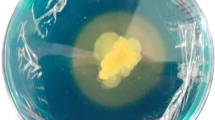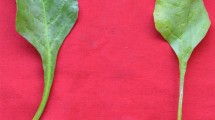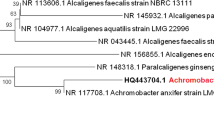Abstract
Iron deficiency is a major global agricultural problem. Siderophores can help organisms to uptake iron in form of siderophore-Fe3+ complexes and then in the cell cytosol, iron is reducted and released in ferrous form. This research aimed to obtain some efficient siderophore-producing bacterial strains and evaluate their plant growth-promoting effects in the iron-deficit environment. Two strains, Brucella sp. E7 and Pseudomonas brassicae W7, were isolated from rhizosphere soil. Both strains could produce maximum siderophores under the optimal conditions. Plant promoting experiment showed that many indicators of Vigna radiata seedling were all increased significantly by strain E7/W7 or the consortium of E7 + W7. Under no-iron and high iron stress, the inoculation treatment also showed growth promotion effects on both Vigna radiata and Lolium multiflorum. These results indicated that the potential ability of strain E7 and W7 in increasing agricultural production as a growth-promoting agent in iron-deficit soil.





Similar content being viewed by others
References
Magdalena AB, Mathilde M, Edith J (2019) Chapter five-siderophores: from natural roles to potential applications. J Adv Appl Microbiol 106:193–225
Ellermann M, Arthur JC (2017) Siderophore-mediated iron acquisition and modulation of host-bacterial interactions. Free Radic Biol Med 105:68–78
Ferreira CMH, Vilas-Boas A, Sousa CA, Soares HMVM, Soares EV (2019) Comparison of five bacterial strains producing siderophores with ability to chelate iron under alkaline conditions. J AMB Express 9:78
Bruno GGD, Gibson DM, Krasnoff SB (2015) Intracellular siderophore but not extracellular siderophore is required for full virulence in Metarhizium robertsii. J Fungal Genet Biol 82:56–68
Cornish AS, Page WI (1995) Production of the triacetecholate siderophore protochelin by Azotobacter vinelandii. Biometals 8:332–338
Etesami H, Emami S, Alikhani HA (2017) Potassium solubilizing bacteria (KSB): mechanisms, promotion of plant growth, and future prospects. J Soil Sci Plant Nutr 17:897–911
Parmar P (2010) Isolation of potassium solubilizing bacteria and their inoculation effect on growth of wheat. Dissertation, Chaudhary Charan Singh Haryana Agricultural University, Hisar
Kaushal M, Wani SP (2016) Plant-growth-promoting rhizobacteria: drought stress alleviators to ameliorate vegetable production in drylands. Ann Microbiol 66:35–42
Kaushal M, Wani SP (2016) Rhizobacterial-plant interactions: strategies ensuring plant growth promotion under drought and salinity stress. Agric Ecosyst Environ 231:68–78
Martins JG, Martin C, Hernandez AL, Maria TB (2018) Azotochelin and N-dihydroxy-N, N’-diisopropylhexanediamide as Fe sources to cucumber plants in hydroponic cultures. Emir J Food Agric 30:65–76
Moon CD, Zhang XX, Matthijs S, Schafer M (2005) Genomic, genetic and structural analysis of pyoverdine-mediated iron acquisition in the plant growth-promoting bacterium Pseudomonas fluorescens SBW25. BMC Microbiol 8:117–121
Storey EP, Boghozian R, Little JL, Chakraborty R (2006) Characterization of “Schizokinen”, a dihydroxamate-type siderophore produced by Rhi-zobiumleguminosarum IARI 917. Biometals 19:637–649
Susilowati LE, Syekhfani S (2014) Characterization of phosphate solubilizing bacteria isolated from Pb contaminated soils and their potential for dissolving tricalcium phosphate. J Degrade Min Lands Manag 1:57–62
Yesica L, Maria G, Viviana C, Gabriela S, Soledad C, Julio R, Maria IS (2018) Production of siderophores by the bacterium Kosakonia radicincitans and its application of phytopathogenic fungi. Bioresour Technol 259:381–387
Harris WR, Amin SA, Kuepper FC, Green DH, Carrano CJ (2007) Borate binding to siderophores: structure and stability. J Am Chem Soc 129:263–271
Graciela MD, de Araceli SP, Vinicius SG, Michele RC (2019) Comparative genomics of Paraburkholderia kururiensis and its potential in bioremediation, biofertilization, and biocontrol of plant pathogens. MicrobiologyOpen 8:112–117
Lane D (1995) 16S 23S rRNA sequencing. In: Stackebrandt E, Goodfellow M (eds) Nucleic acid techniques in bacterial systematics. Wiley, New York, pp 115–175
Kim OS, Cho YJ, Lee K, Yoon SH (2012) Introducing EzTaxon-e: a prokaryotic 16S rRNA gene sequence database with phylotypes that represent uncultured species. J Int J Syst Evol Microbiol 62:716–721
Saitou N (1987) The neighbor-joining method: a new method for reconstructing phylogenetic tree. Mol Biol Evol 4(4):406
Venkat KS, Menon S, Agarwal H, Divya G (2017) Characterization and optimization of bacterium isolated from soil samples for the production of siderophores. J Resour Technol 3:434–439
Schwyn B, Neilands JB (1987) Universal chemical assay for the detection and determination of siderophores. J Anal Biochem 56:47–56
Chaiharn M, Chunhaleuchanon S, Lumyong S (2009) Screening siderophore producing bacteria as a potential biological control agent for fungal rice pathogens in Thailand. World J Microb Biotechnol 25:1919–1928
Li S, Li Y, Leng Y, Zeng X (2019) Nitric oxide donor improves adventitious rooting in mung bean hypocotyl cuttings exposed to cadmium and osmotic stresses. Environ Exp Bot 164:114–123
Zhao L, Wang F, Zhao J (2013) Identification and functional characteristics of chlorpyrifos-degrading and plant growth promoting bacterium Acinetobacter calcoaceticus: characteristics of chlorpyrifos-degrading. J Basic Microb 54:457–463
Zhao L, Teng S, Liu Y (2002) Characterization of a versatile rhizospheric organism from cucumber identified as Ochrobactrum haematophilum. J Basic Microb 52:232–244
Qi W, Zhao L (2013) Study of the siderophore-producing Trichoderma asperellum Q1 on cucumber growth promotion under salt stress. J Basic Microb 53:132–141
Mutai C, Njuguna J, Ghimire S (2017) Brachiaria grasses (Brachiaria spp.) harbor a diverse bacterial community with multiple attributes beneficial to plant growth and development. Microbiologyopen 6:56–77
Pankaj K, Sachin T, Dhingra GK, Abha S, Kumar PM, Kumar H, Dubey RC, Maheshwari DK (2018) Inoculation of siderophore producing rhizobacteria and their consortium for growth enhancement of wheat plant. Biocatal Agric Biotechnol 15:264–269
Cui MX, Ma XX, Liu QQ (2017) Effects of iron fertilizer siphon infusion drip drying on chlorophyll content and FCR activity in apple leaves. North Hortic 12:31–35
Wang X, Xue L, Chang S, He X, Fan T, Wu J, Niu J, Brown E (2019) Bioremediation and metabolism of clothianidin by mixed bacterial consortia enriched from contaminated soils in Chinese greenhouse. Process Biochem 78:114–122
Mahanty T, Bhattacharjee S, Goswami M, Bhattacharyya P, Das B, Ghosh A, Tribedi P (2017) Biofertilizers: a potential approach for sustainable agriculture development. Environ Sci Pollut R 24:3315–3335
Ribeiro M, Simoes M (2019) Siderophores: a novel approach to fight antimicrobial resistance. Rev Biomark Stud Psychiatr Neurodegener Disord 11:99–120
Li F, Duan T, Li Y (2020) Effects of the fungal endophyte Epichloe festucae var. lolii on growth and physiological responses of perennial ryegrass cv. fairway to combined drought and pathogen stresses. Microorganisms. https://doi.org/10.3390/microorganisms8121917
Gu Y F. (2008) Effects of strontium on physiological and biochemical characteristics and mineral element absorption of ryegrass. Dissertation of Zhejiang University
De Serrano LO, Camper AK, Richards AM (2016) An overview of siderophores for iron acquisition in microorganisms living in the extreme. Biometals 29:551–571
Sinha AK, Parli Venkateswaran B, Tripathy SC, Sarkar A (2019) Effects of growth conditions on siderophore producing bacteria and siderophore production from Indian ocean sector of Southern Ocean. J Basic Microb 59:859–960
Tailor AJ, Joshi BH (2012) Characterization and optimization of siderophore production from Pseudomonas fluorescens strain isolated from sugarcane rhizosphere. J Environ 6:688–694
Calvente V, de Orellano ME, Sansone G, Benuzzi D (2001) Effect of nitrogen source and pH on siderophore production by Rhodotorula strains and their application to biocontrol of phytopathogenic moulds. J Ind Microbiol Biotechnol 26:226–229
Sharma T, Kumar N, Rai N (2016) Production and optimization of siderophore producing pseudomonas species isolated from Tarai region of Uttarakhand. Int J Pharm Bio Sci 7:306–314
Tripathi M, Johri BN, Sharma A (2006) Plant growth–promoting pseudomonas sp. strains reduce natural occurrence of anthracnose in soybean (glycine maxl.) in central Himalayan region. Curr Microbiol 52:390–394
Bisen P (2014) Soil biology. Laboratory protocols in applied life sciences, 1st edn. CRC Press, Boca Ratan, FL, USA, pp 771–888
Postle K (1990) Aerobic regulation of the Escherichia coli Ton-B gene by changes in iron availability and the fur locus. J Bacteriol 172:2287–2293
Oreto F, Valla SMP, Ana GC, Cristina M, Castillo AM (2015) Doubled haploid production from Spanish onion (Allium cepa L.) germplasm: embryogenesis induction, plant regeneration and chromosome doubling. Front Plant Sci 6:33–36
Li DX, Guo YX, Yuan HY, Zhang M (2005) Determination of chlorophyll content in maize. Chin Agric Sci Bull 6:153–155
Noinaj N, Guillier M, Barnard TJ, Buchanan SK (2010) TonB-dependent transporters: regulation, structure, and function. J Annu Rev Microbiol 64(1):43–60
Braud A, Hoegy F, Jezequel K, Lebeau T (2009) New insights into the metal specificity of the Pseudomonas aeruginosa pyoverdine-iron uptake pathway. Environ Microbiol 11:1079–1091
Naveed M, Mitter B, Reichenauer TG, Wieczorek K (2014) Increased drought stress resilience of maize through endophytic colonization by Burkholderia phytofirmans PsJN and Enterobacter sp. FD17. Environ Exp Bot 97:30–39
Etesami H, Maheshwari DK (2018) Use of plant growth promoting rhizobacteria (PGPRs) with multiple plant growth promoting traits in stress agriculture: action mechanisms and future prospects. Ecotoxicol Environ Safe 156:225–246
Verma VC, Singh SK, Prakash S (2011) Biocontrol and plant growth promotion potential of siderophore producing endophytic Streptomyces from Azadirachta indica A Juss. J Basic Microb 51:550–556
Raymond KN, Dertz EA, Kim SS (2003) Enterobactin: an archetype for microbial iron transport. Proc Natl Acad Sci USA 100:3584–3588
Acknowledgements
This study was funded by the Scientific Research Project from Facing Characteristic Discipline of Bei**g Union University (KYDE40201703); Bei**g Key Laboratory of Bioactive Substances and Functional Foods, Bei**g Union University (12213991724010239); the National Natural Science Foundation of China (31860163); Key Research and Development Project of Gansu Province (20YF3NA018).
Author information
Authors and Affiliations
Contributions
Conceived and designed the experiments: YS. Performed the experiments: JW, XS, GJ. Analyzed the data: YS, JN. Contributed reagents/materials/analysis tools: LX. Wrote the paper: JW, BE. Thanks to Dr. GZ for the Language modifications to this article.
Corresponding authors
Ethics declarations
Conflict of interest
The authors have no conflicts of interest to declare that are relevant to the content of this article. This study does not contain any studies involving human or animal subjects.
Ethical Approval
This article does not contain any studies with human participants or animals performed by any of the authors. Moreover, all authors read and approved the final manuscript.
Additional information
Publisher's Note
Springer Nature remains neutral with regard to jurisdictional claims in published maps and institutional affiliations.
Supplementary Information
Below is the link to the electronic supplementary material.
Rights and permissions
About this article
Cite this article
Sun, Y., Wu, J., Shang, X. et al. Screening of Siderophore-Producing Bacteria and Their Effects on Promoting the Growth of Plants. Curr Microbiol 79, 150 (2022). https://doi.org/10.1007/s00284-022-02777-w
Received:
Accepted:
Published:
DOI: https://doi.org/10.1007/s00284-022-02777-w




